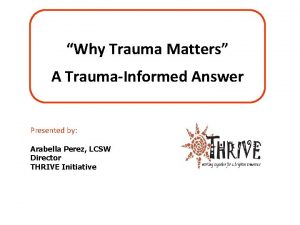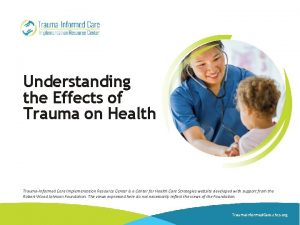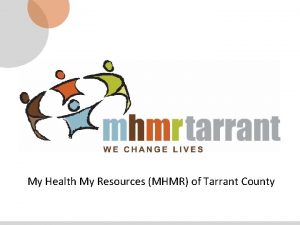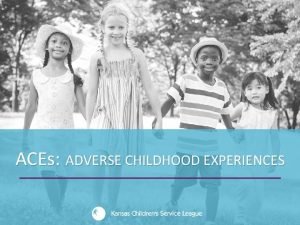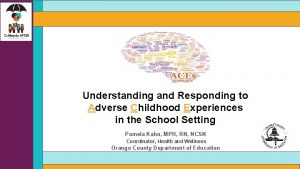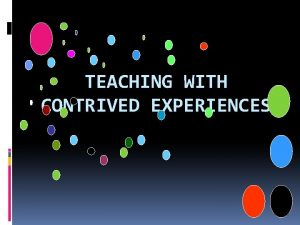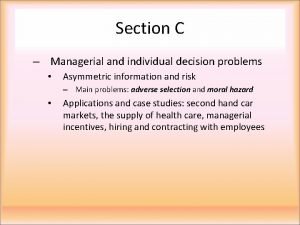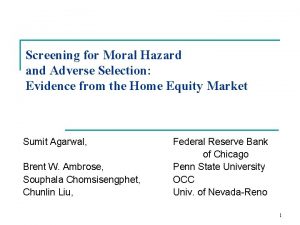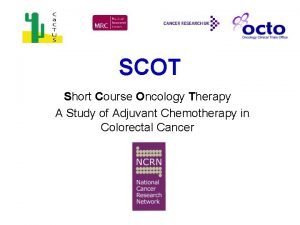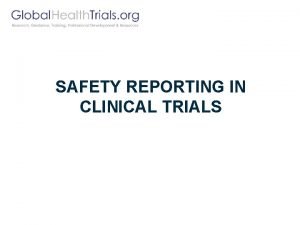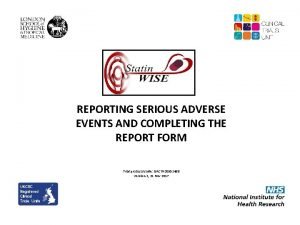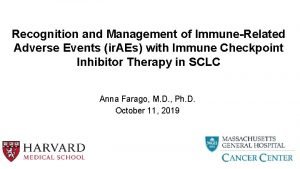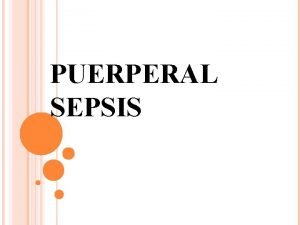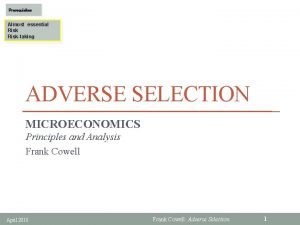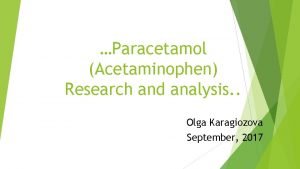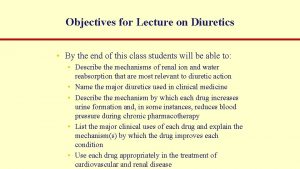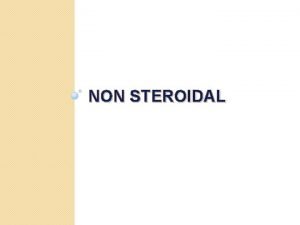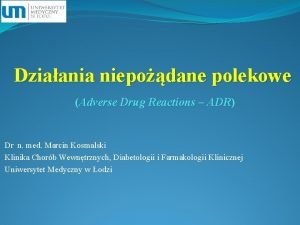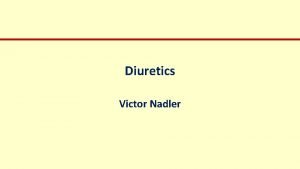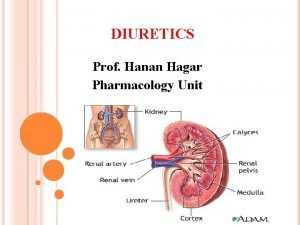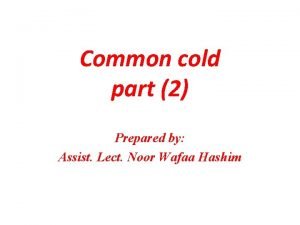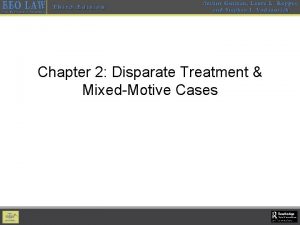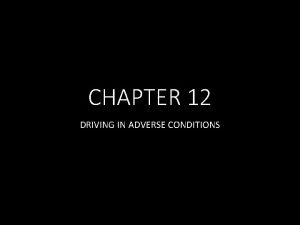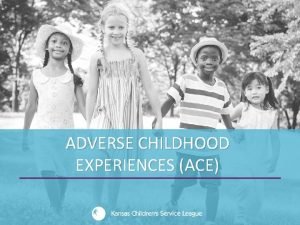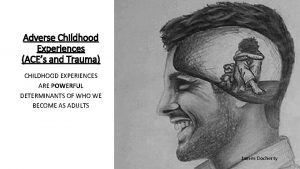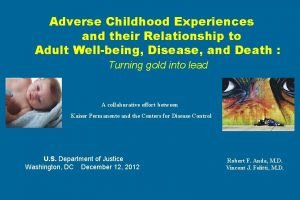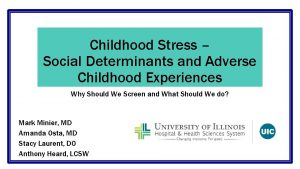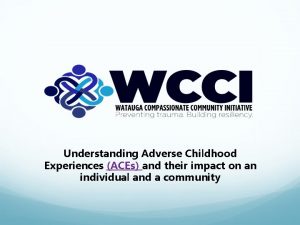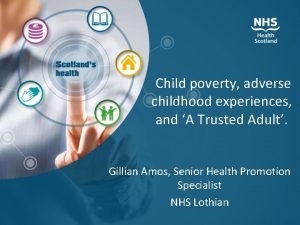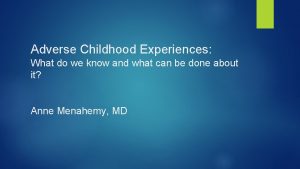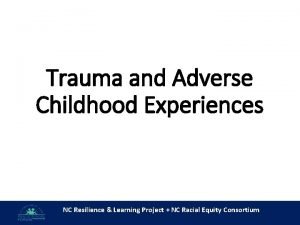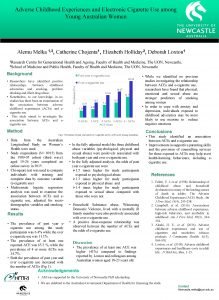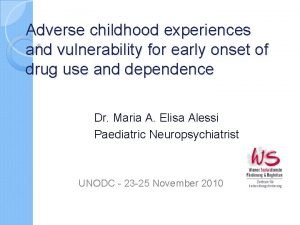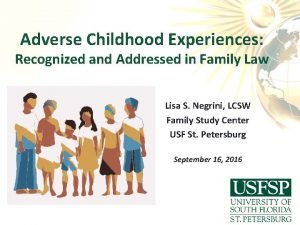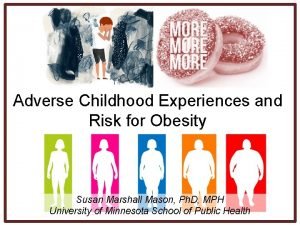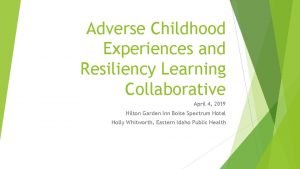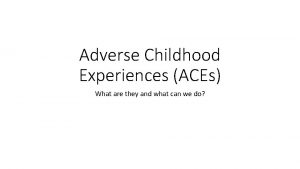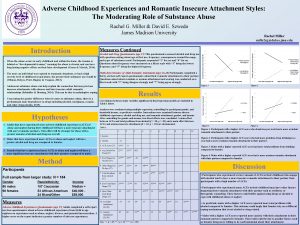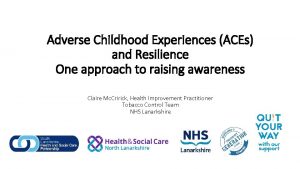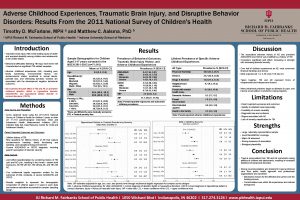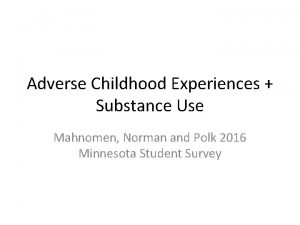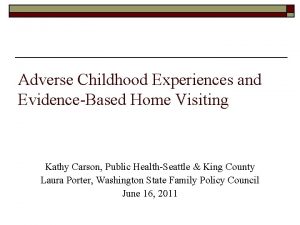Adverse Childhood Experiences and their Repressed Relationship to





























- Slides: 29

Adverse Childhood Experiences and their Repressed Relationship to Adult Well-being, Disease, and Death : Turning gold into lead A collaborative effort between Kaiser Permanente and the Centers for Disease Control Integrating Trauma into Healthcare San Diego, CA January 29, 2018 Robert F. Anda, M. D. (CDC) Vincent J. Felitti, M. D. (SCPMG)

The ACE Study Summary of Findings: • Adverse Childhood Experiences (ACEs) are very common, and disturbing, and hence are mostly unrecognized. • They are powerful predictors of adult social malfunction, distress, health risks, disease, and premature death. • This combination makes ACEs the leading determinant of the health, social well-being, and economy of the nation.

Origins of the ACE Study In 51 weeks: 408 to 132 lbs Age 8 Age 29 Which photo represents the patient’s problem?

ACE Study Design Survey Wave 1 71% response (9, 508/13, 454) n=13, 000 71% response All medical evaluations abstracted Survey Wave II n=13, 000 All medical evaluations abstracted vs. Mortality National Death Index Present Health Status & 17, 337 adults Morbidity Hospital Discharges Doctor Office Visits Emergency Room Visits Pharmacy Costs

Empirically Selected Categories of Adverse Childhood Experiences Abuse, by Category Psychological (by parents) Physical (by parents) Sexual (anyone, but typically family) Prevalence (%) 11% 28% 22% Major Neglect, by Category Emotional Physical 15% 10% Household Dysfunction, by Category Alcoholism or drug use in home Loss of biological parent <18 Depression or mental illness in home Mother treated violently Imprisoned household member 27% 23% 17% 13% 5%

Adverse Childhood Experiences Score Number of categories (not events) is summed… ACE Score Prevalence 0 33% 1 25% 2 15% 3 10% 4 6% 5 or more 11%* • Two out of three adults experienced at least one category of ACE. • If any one ACE is present, there is an 87% chance at least one other category of ACE is present, and a 50% chance of three or more. • Women are 50% more likely than men to have an ACE Score >5.

The Hidden Threat of Weight Loss The ‘Problem’ is her SOLUTION!

Molestation in Childhood Obesity runs in this family. So does speaking English. Familial does not mean genetic.

Nicotine to Self-Medicate Is he describing dysfunctional behavior, or is it functional in realms of which we know nothing?

Health Risks Adverse Childhood Experiences vs. >1 ppd Smoking as an Adult % P<. 001

Social function Childhood Experiences vs. Adult Alcoholism 4+ 3 2 1 0

Health Risks ACE Score vs. Intravenous Drug Use p<0. 001

An ad from the 1940 s, for the Profession

Functional aspects of ‘dysfunctional’ behavior Lost 158 pounds in Program. But, why did he gain it?

The Hidden Threat of Weight Loss

A Public Health Paradox What we conventionally view as Public Health problems are often a patient’s solutions to long-concealed adverse childhood experiences.

A Former Pediatric Patient Speaks Clearly

Well-being Childhood Experiences Underlie Chronic Depression

Death Childhood Experiences Underlie Suicide Attempts 4+ 3 2 0 1

Costs Prescription rate per 100 person-years) Childhood Experiences Underlie Prescription of Antidepressants 50 Years Later 5 or 4 2 3 1 0 ACE Score more

Disease Ever Hallucinated* (%) ACE Score and Hallucinations Abused Alcohol or Drugs ACE Score* *Adjusted for age, sex, race, and education.

Social malfunction: ACE Score and Indicators of Impaired Worker Performance 25 Impaired Performance (%) ACE Score Prevalence of 20 0 1 2 3 4 or more 15 10 5 0 Absenteeism (>2 days/month) Serious Financial Problems Serious Problems Performing job

Biomedical disease ACEs Increase Likelihood of Heart Disease* • • • Emotional abuse Physical abuse Sexual abuse Domestic violence Mental illness Substance abuse Household criminal Emotional neglect Physical neglect 1. 7 x 1. 5 x 1. 4 x 1. 3 x 1. 7 x 1. 3 x 1. 4 x * After correction for age, race, education, and conventional risk factors like smoking and. diabetes. Circulation , Sept 2004

Newly Recognized Biomedical Relationships

Resilience?

ACE Study Summary Adverse Childhood Experiences are common and they typically affect adult: • Job performance, disability, and social malfunction • Well-being, depression, and earnings • Obesity, smoking, alcoholism, and drug use • Biomedical disease burden and life expectancy • Medical care costs • Subsequent generations.

Obtaining the Information

Turning Research into Practice a beginning • Set up properly, and in high volume, comprehensive medical evaluation affordably can be provided to all patients at the outset of ongoing medical care. • Comprehensive biomedical evaluation provided a net 11% reduction in DOVs in the subsequent year. • Comprehensive biopsychosocial evaluation, which incorporates ACE Study findings, provided a 35% reduction in DOVs in the subsequent year compared to the prior year. (130, 000 patient sample) Imagine the possibilities!

Further Information www. ACEs. Connection. com Internet and You. Tube: search “ACE Study” http: //www. cdc. gov/NCCDPHP/ACE/ AVAHealth. org (Detailed 4 -hour DVD) “The Deepest Well”, new book by N. Burke-Harris, MD VJFMDSDCA@mac. com
 Adverse childhood experiences study
Adverse childhood experiences study Adverse childhood experiences study
Adverse childhood experiences study Mhmr of tarrant county
Mhmr of tarrant county Schoolsworkpro
Schoolsworkpro What are adverse childhood experiences
What are adverse childhood experiences Repressed memories
Repressed memories Infancy early childhood middle childhood adolescence
Infancy early childhood middle childhood adolescence Contrived experience example
Contrived experience example Difference between rm and crm
Difference between rm and crm Adverse reaction definition
Adverse reaction definition Near miss root cause analysis
Near miss root cause analysis Adverse selection
Adverse selection Adverse selection
Adverse selection Adverse reaction definition
Adverse reaction definition Adverse reaction definition
Adverse reaction definition Adverse events in hospital
Adverse events in hospital Adverse events in hospital
Adverse events in hospital Puerperal sepsis definition
Puerperal sepsis definition What is adverse selection
What is adverse selection Mechanism of action of acetaminophen
Mechanism of action of acetaminophen Loop diuretics adverse effects
Loop diuretics adverse effects Paracetamol dose per kg
Paracetamol dose per kg Vildagliptin renal dose adjustment
Vildagliptin renal dose adjustment Adverse selection
Adverse selection Adr adverse drug reaction
Adr adverse drug reaction Harley nadler
Harley nadler Classification of diuretics
Classification of diuretics Hayanil side effects
Hayanil side effects Adverse treatment
Adverse treatment Chapter 12 driving in adverse conditions
Chapter 12 driving in adverse conditions
